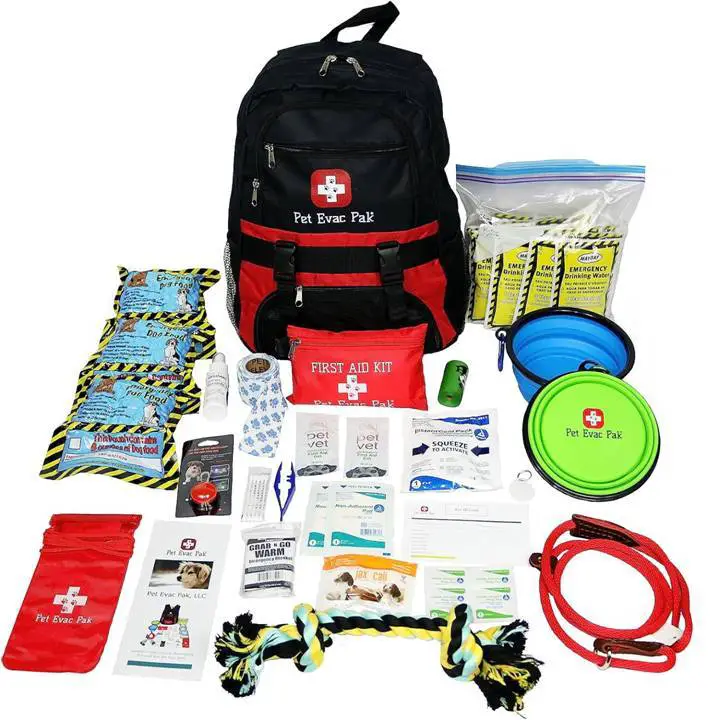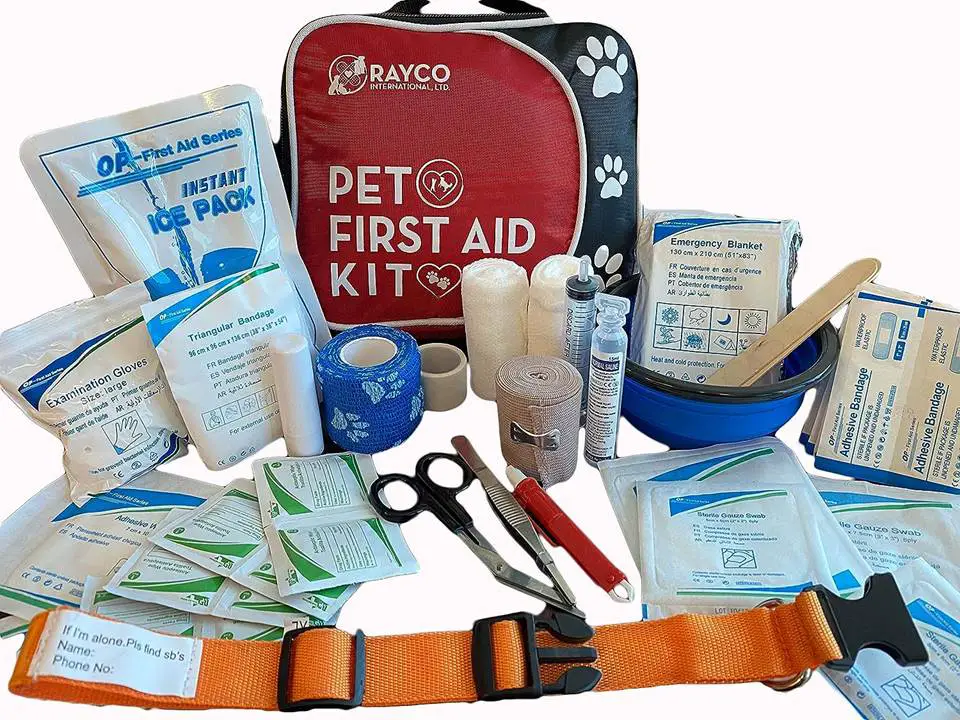Estimated reading time: 10 minutes
Some of us spend a lot of time thinking about potential emergencies as a result of natural or manmade disasters. The result is that we put together emergency plans, bug out kits, and make other preparations –just in case. What we sometimes miss are the needs of any pets we have in the family.
An evacuation for any disaster is a stressful time and there are few of us who would think about leaving home without the family dog or cat. For that matter, many people are very attached to other pets like birds and even hamsters and other small, caged animals can be difficult to leave behind especially for children.
The result is that it’s worth taking some time to think about how you can evacuate yourself and your pets and prepare for their needs.
Want to save this post for later? Click Here to Pin It On Pinterest!
Dogs and Cats Tend to Be the Priority
The amount of interaction people have with dogs and cats creates a bond that’s difficult to ignore. But regardless of which pets or how many pets you want to care for in an emergency, you need to think about their needs in emergencies whether you’re at home or bugging out.
Here are some general things to think about with any pet as we plan for an emergency pet survival kit:
√ Food
Most pets live on a diet of specialized foods developed uniquely for them. Most of us are pretty strict about not feeding table scraps to our cats or dogs, and most small pets like birds and other animals have special types of foods ranging from seeds to food pellets.
What’s important is to have some of these foods in reserve for emergencies. How much is hard to estimate but it makes sense to have as much as you have for yourself. If you are assuming the average duration of an evacuation or disaster you would be planning for 72-hours. Do the same for your pets.
It also makes sense that the rules are different during a disaster and your table scraps may soon find their way to your dog or cats dish if you run out of pet food.
√ Water
The amount of water any pet requires on a daily basis varies depending on their body weight, diet and activity level. Here’s a link to a website with general guidelines for water needs for various pets.
Once again, the amount is as hard to estimate for your pets as it is for you and your family. Plan to have as much for them as you have for everyone else in terms of duration. If you’re preparing for 3-days for your water needs, plan for 3-days for your pet’s water supply as well.
√ Medications
Some pets require regular medications for pain, anxiety or other conditions. Make sure you have extra on hand and set aside for your pet’s emergency kit. The quantity should match the other quantities you are putting together for a specific number of days.
It’s also wise to add OTC pet medications you might need including basics like flea and tick collars and de-worming medications. There are many other medications sometimes recommended for pets but watch the dosage. Here’s a link to a PDF identifying dosages for dogs and cats and some medications to simply avoid giving to them.
And while you’re at it, make sure all of your pet’s shots and inoculations are up to date. We’ll go into detail on a pet first aid kit later in this article.
√ Equipment and Supplies
Pets require some specialized equipment and supplies from food and water bowls to leashes, collars, muzzles and even small cushioned beds, blankets and a few of their favorite toys. You might also want to think about a small kennel for your pet. If you find yourself in a shelter during an emergency they may prohibit pets unless contained in a small kennel or pen.
The easiest way to plan for equipment and supplies is to think about what you already use at home and take it with you.
√ Documentation
Make sure you keep important records for your pet in your pet emergency kit including vaccination records and any other documentation related to your pet. Include a photo with you and your pet in case they get lost or separated to allow you to prove they are in fact your pet. Typically they'll be very enthusiastic about seeing you and that will be good evidence that it's your dog, but some cat owners may wonder about that whole enthusiasm thing.
Some people have a microchip implanted in their pets to help them find them in the event that they get lost. There are also Bluetooth trackers that you can attach to their collar. At the least, make sure their pet’s tags are accurate with the pets name, your name and your phone number plus critical vaccination tags.
Have a Plan for Your Pets
It all seems so straightforward during an evacuation. You pack up the gear and your family and your dog or cat and head out. Hopefully you avoid traffic jams because you’ve looked at alternative routes and your destination is a hotel far from the disaster. And then –you find out the hotel won’t allow pets.
You continue to search for a place to stay but no luck. It all would have been so easy if a phone call ahead could have located a pet friendly hotel, or at least given you the chance to consider the home of a distant relative or friend as a destination.
Understanding some of the limitations or challenges of bugging out with a pet requires a bit of planning. Here are some thoughts to ponder:
- Make sure your destination allows pets whether it’s a campsite, hotel/motel, shelter, or even a friend’s home. At a time where there may be one too many surprises you don’t need to find out your friend’s daughter is allergic to cats. Call ahead or check it out on the Internet.
- Make sure you leave room for your pet in your vehicle. When you’re packing during an evacuation it’s easy to forget that every seat is full and there’s no room left for the family dog.
- If you’re staying home or bugging in during an emergency, the family dog can be an excellent alarm system for anyone in the vicinity of your home. Plan on keeping your dog close and possibly in your bedroom or the kid’s room where you can be easily alerted to their sudden attention to anything outside or inside.
- A dog can also serve this alert/protection function when on the road during an evacuation.
A Pet Emergency Kit

As you would expect, you can buy a pet emergency kit. The only limitation is that they tend to be focused on dogs and lack some of the unique things that your dog or cat or other pet may uniquely need.
You could always supplement one of these kits with any of those unique items but were going to assemble our own. The quantities we’ll identify when relevant are for a 72-hour emergency. You’ll need to add to the kit if you are planning for an emergency that goes beyond 3-days. Here are the elements including some details on a pet first aid kit:
Basic Pet Emergency Kit
- Pet Food in an airtight container (It may be better to just pack as much as you have room for but at least 3-days worth)
- Water in a water bottle sufficient for your pet’s size and weight for at least 3-days
- Food and water bowls (There are collapsible bowls that pack smaller)
- Collar or harness
- Leash
- 10 to 20 foot cable with clips so your pet has some room to roam when leashed in a location.
- Paw protectors or pads (for rugged or unknown terrain and debris)
- Pet clean up bags (You never know where or when your pet is going to want to “go.”
- Kitty litter
- Medication kit for unique medicines for your pet
- 2 or 3 toys that your pet uniquely likes
- A fleece or fabric blanket for comfort and warmth
- A pet bed if you have room. You never know where you all may be sleeping.
- Document folder for pet documentation
- Pet first aid kit

You can buy preassembled pet first aid kits. It makes it a little easier to have a kit on hand but you could put one together yourself. Besides, many of the items in a pet first aid kit from bandages to antiseptic creams are the same you would find in a regular first aid kit.
Here are the unique items that are usually found in a pet first aid kit:
- Styptic pencil to stop bleeding
- Tick remover (padded plastic tweezers)
- Plastic syringe for administering liquids or medicines to an animal
Other than those items the contents are the same as any standard first aid kit. It’s probably best to simply buy a first aid kit for the whole family and add those 3 items we listed above. If you can think of anything else you might need to care for your pet –add it to the kit.
And Then There’s Livestock
In the grand scheme of things, house pets are easy –livestock is another story. Anyone living a homesteading lifestyle has livestock to think about even if it’s just a modest chicken coop or rabbit pen in a suburban back yard.
Recommendations for what to do about livestock during a natural disaster or evacuation varies. Here are some of the ideas put forward by various livestock owners:
- Purchase a trailer that allows you to transport your livestock to a safe location.
- Relocate them to high ground or a safe location like a barn or fenced meadow and let them free-roam in those areas with access to food and water.
- Totally release them and let them free roam.
- Sell them.
We’ll get to some links to articles and videos with more advice on this and other subjects related to animals and pets, but livestock is a significant challenge. And don’t assume that people don’t get attached to livestock. Just ask anyone who owns a horse or has a favorite pair of goats.
The Pet Benefit
It’s unthinkable for some people to imagine leaving their pets behind and there are significant benefits to making sure the family dog or cat travels with you.
- For one, there’s the emotional reward. Pets are a particular comfort for children and in stressful times can help relieve the pressure of the situation.
- Dogs are an excellent alarm system and can alert you to something or someone in your vicinity long before you notice anything.
- Dogs can provide some level of protection and security depending on its size and breed.
- A shared sleeping arrangement with a pet adds more body heat to primitive shelters like tents or lean-tos.
- Having your pets with you relieves you of the anxiety of leaving them behind. Few of us wouldn’t find ourselves agonizing over how they were doing especially if the emergency goes into a longer duration.
Doing Some Homework
Here are some very good links to more information about pet emergency kits and how to handle various situations with regards to pets and livestock:
- Bug Out Bag for Dogs – Pets DIY Emergency Kit
- How To Put Together an Emergency Kit for Your Dog
- Bug Out Basics for Homesteaders
- Pet Emergency Kit Checklist and Disaster Preparedness
- Pet Disaster Preparedness Kit
- Pet Disaster Preparedness
- First aid tips for pet owners
- Emergency Preparedness for Farm Animals
It’s Not that Hard
For most of us it’s impossible to imagine leaving our dogs or cats behind in the midst of an emergency. With a little research, pre-planning and preparations like assembling a pet emergency kit it can all be a lot easier for everyone. We’ll all have enough on our minds when disaster strikes and a family pet can at least make things feel a little bit normal.
Like this post? Don't Forget to Pin It On Pinterest!









